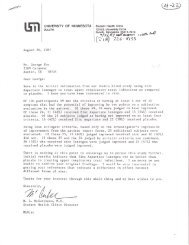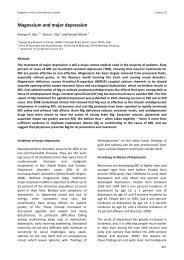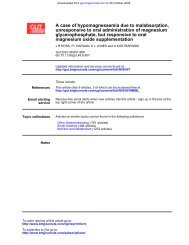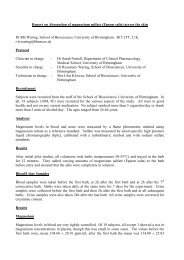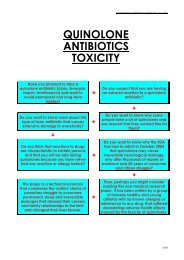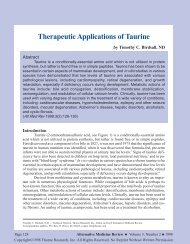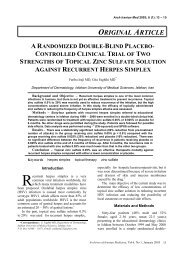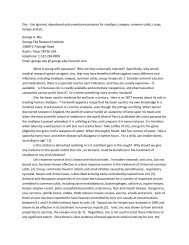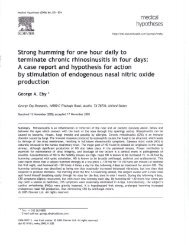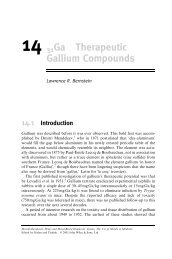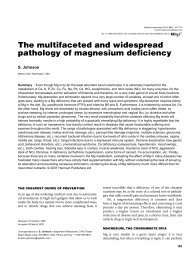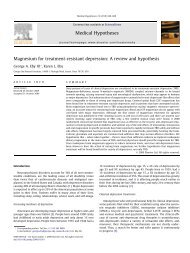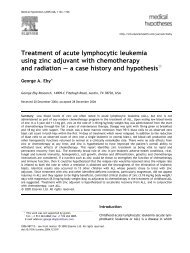About the Misdiagnosis of Magnesium Deficiency - George Eby ...
About the Misdiagnosis of Magnesium Deficiency - George Eby ...
About the Misdiagnosis of Magnesium Deficiency - George Eby ...
You also want an ePaper? Increase the reach of your titles
YUMPU automatically turns print PDFs into web optimized ePapers that Google loves.
<strong>About</strong> <strong>the</strong> <strong>Misdiagnosis</strong> <strong>of</strong> <strong>Magnesium</strong> <strong>Deficiency</strong><br />
Dierck-Hartmut Liebscher, MD, Dr Sc Nat, Dierck-Ekkehard Liebscher, Dr Sc Nat<br />
Self-Help Organisation on Mineral Imbalances, Task Force <strong>Magnesium</strong>-<strong>Deficiency</strong> Tetany, Berlin, GERMANY<br />
Key words: <strong>Magnesium</strong>-deficiency tetany, self-help, diagnosis, serum analysis<br />
THE ERRORS<br />
The experience <strong>of</strong> our self-help organisation shows that <strong>the</strong> reason patients with symptoms <strong>of</strong> magnesium<br />
(Mg) deficiency do not get Mg <strong>the</strong>rapy is acceptance <strong>of</strong> an inappropriate lower limit <strong>of</strong> <strong>the</strong> reference values for<br />
serum Mg concentration. The commonly designated low limit <strong>of</strong> <strong>the</strong> normal range seems to have been selected<br />
from values obtained for symptomatic patients. It is below levels that exist in patients with marginal deficiencies<br />
that can predispose to development <strong>of</strong> pathologic findings, so that <strong>the</strong> prevalence and importance <strong>of</strong> this disease<br />
is insufficiently considered. The lower reference limit <strong>of</strong> <strong>the</strong> normal population is erroneously regarded as a<br />
diagnostic criterion that excludes Mg deficiency when <strong>the</strong> serum level is even slightly above <strong>the</strong> reference limit<br />
that only excludes normality at lower levels. It is a statistical error to use <strong>the</strong> confidence limits <strong>of</strong> <strong>the</strong> normal<br />
population as <strong>the</strong> exclusion limit for those with abnormal Mg status.<br />
Mg deficiency is widespread, but under-detected because<br />
<strong>of</strong> <strong>the</strong> role <strong>of</strong> Mg, not only is <strong>the</strong> plasma, but intracellularly.<br />
● The first diagnostic error is failure to recognize relevant<br />
symptoms as part <strong>of</strong> a Mg deficiency syndrome<br />
(MDS) [1]<br />
● The second error is to interpret symptoms due to Mg<br />
deficiency as irrelevant, because associated with decline<br />
<strong>of</strong> somatic functions with age.<br />
● The third error: misinterpretation <strong>of</strong> significance <strong>of</strong><br />
serum Mg levels, as <strong>the</strong> test <strong>of</strong> validity <strong>of</strong> diagnosis<br />
<strong>of</strong> Mg deficiency is considered in more detail<br />
below.<br />
● The fourth error pertains more to inadequate Mg repletion<br />
than to diagnosis. When <strong>the</strong> practitioner has<br />
been convinced to start Mg on <strong>the</strong> basis <strong>of</strong> his diagnosis<br />
or through insistence <strong>of</strong> <strong>the</strong> patient, <strong>the</strong> <strong>of</strong>ten<br />
recommended dose <strong>of</strong> 300 mg per day is insufficient.<br />
Experience <strong>of</strong> successful <strong>the</strong>rapy indicates that no less<br />
than 600 mg per day is required.<br />
● Mg is a normal component <strong>of</strong> <strong>the</strong> body, ra<strong>the</strong>r than a<br />
drug, that is normally absent in <strong>the</strong> body. Thus its<br />
metabolism is regulated, and <strong>the</strong> immediate effect <strong>of</strong><br />
supplemented Mg is moderate. Mg <strong>the</strong>rapy usually<br />
requires at least one or two weeks for notable improvement<br />
to become manifest.<br />
THE TEST<br />
Let us assume that <strong>the</strong> practitioner has identified <strong>the</strong> symptoms<br />
as part <strong>of</strong> <strong>the</strong> MDS and intends to start a test based on <strong>the</strong><br />
value <strong>of</strong> <strong>the</strong> serum Mg concentration.<br />
In <strong>the</strong> literature, among <strong>the</strong> different critical values mentioned<br />
are: 0.8 mmol/l Mg [2] (Fig. 1), 0.75 mmol/l Mg [3], and<br />
0.7 mmol/l Mg [4], but most <strong>of</strong> <strong>the</strong>m without correct statistical<br />
foundation. We derive, from <strong>the</strong> data published by von Ehrlich,<br />
1997 [5] that:<br />
● <strong>the</strong> average value for <strong>the</strong> magnesium deficient patient<br />
is probably higher than 0.75 mmol/l Mg;<br />
● when <strong>the</strong> distribution is symmetric, a critical value <strong>of</strong><br />
0.8 mmol/l Mg misses about 10% <strong>of</strong> affected patients.<br />
The estimation <strong>of</strong> <strong>the</strong> mean value for <strong>the</strong> normomagnesemic<br />
persons without clinical symptoms varies around <strong>the</strong> value <strong>of</strong><br />
0.9 mmol/l Mg. When <strong>the</strong> distribution for <strong>the</strong> affected is<br />
Gaussian, a critical value <strong>of</strong> 0.9 mmol/l Mg misses only 1% <strong>of</strong><br />
those affected.<br />
Von Ehrlich had diagnosed 366 (9.4%) patients, among<br />
3894 who had symptoms <strong>of</strong> a clinically relevant MDS and<br />
whose serum values were less than 0.8 mMol/l Mg [2]. If<br />
patients with more than <strong>the</strong> low limit <strong>of</strong> 0.7 mmol/l Mg [2]<br />
were considered as normomagnesemic, more than 329 Mgdeficient<br />
patients would be erroneously declared as normomagnesemic.<br />
In <strong>the</strong>se cases (that amount to 90% <strong>of</strong> <strong>the</strong> affected<br />
patients!) unfortunately, no Mg <strong>the</strong>rapy would be started. Accepting<br />
0.75 mmol/l Mg as <strong>the</strong> critical value [3], von Ehrlich<br />
Address reprint requests to: Dierck-Hartmut Liebscher, MD, Dr Sc Nat, Self-Help Organisation on Mineral Imbalances, Task Force <strong>Magnesium</strong>-<strong>Deficiency</strong> Tetany,<br />
Rummelsburger Str. 13, D-10315 Berlin, GERMANY. E-mail: dierck-h.liebscher@magnesiumhilfe.de<br />
Journal <strong>of</strong> <strong>the</strong> American College <strong>of</strong> Nutrition, Vol. 23, No. 6, 730S–731S (2004)<br />
Published by <strong>the</strong> American College <strong>of</strong> Nutrition<br />
730S
missed 183 (50%) <strong>of</strong> <strong>the</strong> affected patients. When one accepts<br />
that at least some <strong>of</strong> <strong>the</strong> undiagnosed 3528 person in <strong>the</strong> sample<br />
<strong>of</strong> 3894 persons showing symptoms <strong>of</strong> MDS really had magnesium<br />
deficiency, <strong>the</strong> critical value <strong>of</strong> 0.7 mmol/l Mg is more<br />
than 90% wrong for <strong>the</strong> ill!<br />
STATISTICS<br />
It is a common statistical error to use <strong>the</strong> confidence limits<br />
<strong>of</strong> <strong>the</strong> normal population as exclusion limits for <strong>the</strong> affected<br />
(see <strong>the</strong> diagram below).<br />
In any decision between two alternatives (i.e.: normal person<br />
and patient) <strong>the</strong>re is <strong>the</strong> potential <strong>of</strong> making two distinct<br />
errors. First, a person without Mg deficiency can erroneously<br />
be diagnosed as having a deficiency (error <strong>of</strong> <strong>the</strong> first kind).<br />
Second, a patient with a deficiency can erroneously be declared<br />
normal and remain undetected (error <strong>of</strong> <strong>the</strong> second kind).<br />
The decision procedure entails selection <strong>of</strong> <strong>the</strong> condition to<br />
be treated. Because it can be determined by calculation, <strong>the</strong><br />
error <strong>of</strong> <strong>the</strong> first kind is usually chosen to be 0.05 or 0.01.<br />
However, <strong>the</strong> smaller <strong>the</strong> error <strong>of</strong> <strong>the</strong> chosen first kind, <strong>the</strong><br />
larger <strong>the</strong> error <strong>of</strong> <strong>the</strong> second kind will necessarily be [6]. In<br />
most cases, <strong>the</strong> error that implies higher risk or higher costs<br />
should be minimized. The decision through use <strong>of</strong> <strong>the</strong> serum<br />
concentration must respect <strong>the</strong> distribution <strong>of</strong> this value for<br />
affected patients, and must not use <strong>the</strong> distribution for normal<br />
persons.<br />
CONCLUSIONS<br />
Based on experience, it is our on conviction that many<br />
patients with so-called exclusion diagnoses (as for example,<br />
attention deficit hyperactivity disorder (ADHD) or chronic<br />
fatigue syndrome (CFS) would have <strong>the</strong>ir symptoms improved<br />
through Mg <strong>the</strong>rapy.—Similarly, patients with diagnoses <strong>of</strong><br />
depression, epilepsy, diabetes mellitus, tremor, Parkinsonism,<br />
arrhythmias, circulatory disturbances (stroke, cardiac infarction,<br />
arteriosclerosis), hypertension, migraine, cluster headache,<br />
cramps, neuro-vegetative disorders, abdominal pain, osteoporosis,<br />
asthma, stress dependent disorders, tinnitus, ataxia,<br />
Fig. 1. Illustration <strong>of</strong> <strong>the</strong> data published by von Ehrlich [2].<br />
confusion, preeclampsia, weakness, might also be consequences<br />
<strong>of</strong> <strong>the</strong> magnesium deficiency syndrome.<br />
● Patients with symptoms that can be part <strong>of</strong> <strong>the</strong> Mg<br />
deficiency syndrome should have <strong>the</strong>ir Mg serum values<br />
determined.<br />
● In patients with Mg serum values lower than 0.9<br />
mmol/l Mg, magnesium supplementation is recommended;<br />
for patients with values lower than 0.8<br />
mmol/l, starting Mg supplementation is necessary. We<br />
recommend that a mMg serum value <strong>of</strong> 0.9 mmol/l Mg<br />
be considered as <strong>the</strong> lower reference limit, in evaluating<br />
symptoms or diseases suspected as being associated<br />
with Mg deficiency. In this case, Mg has to be<br />
used as a first choice <strong>the</strong>rapy. When symptoms <strong>of</strong> <strong>the</strong><br />
MDS are found, patients with serum values <strong>of</strong> less than<br />
0.8 mmol/l Mg, or better 0.9 mmol/l Mg, ought not be<br />
erroneously declared normomagnesemic.<br />
● When Mg substitution is started, <strong>the</strong> minimum dose to<br />
be applied is 600 mg Mg per day.<br />
● The <strong>the</strong>rapy should proceed for more than one month,<br />
and <strong>the</strong>n continue with a dose that holds <strong>the</strong> serum<br />
value not lower than 0.9 mmol/l Mg.<br />
REFERENCES<br />
1. Durlach J: “<strong>Magnesium</strong> in der klinischen Praxis.” Jena und Stuttgart:<br />
Fischer-Verlag, 1992.<br />
2. Thomas L: Klinisch relevante Laborwerte. In Harrison: “Innere<br />
Medizin,” 13th ed. New York: McGraw-Hill, pp 2915–2920, 1995.<br />
3. Dörner K: <strong>Magnesium</strong>. In Thomas L (ed): “Labor und Diagnose.”<br />
Frankfurt/Main: TH-Books VG, 2000.<br />
4. Köhler H: Störungen des Wasser- und Elektrolythaushaltes. In<br />
Weihrauch TR (Hrsg): “Wol. und Weihrauch: Internistische Therapie<br />
2000–2001.” München, Jena: Urban & Fischer-Verlag, pp<br />
299–317, 2000.<br />
5. Publizierte Patientendaten: Von Ehrlich B: <strong>Magnesium</strong>mangelsyndrom<br />
in der internistischen Praxis. Magnes Bulletin 19:29–30, 1997.<br />
6. Lehmann EF: “Ma<strong>the</strong>matical Statistics.” New York: J Wiley, 1960.<br />
Received August 5, 2004.<br />
<strong>Misdiagnosis</strong> <strong>of</strong> <strong>Magnesium</strong> <strong>Deficiency</strong><br />
JOURNAL OF THE AMERICAN COLLEGE OF NUTRITION 731S



